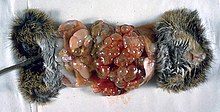Echinococcus
This article needs additional citations for verification. (December 2009) |
| Echinococcus | |
|---|---|

| |
| Necropsy of a cotton rat infected with Echinococcus multilocularis | |
| Scientific classification | |
| Domain: | Eukaryota |
| Kingdom: | Animalia |
| Phylum: | Platyhelminthes |
| Class: | Cestoda |
| Order: | Cyclophyllidea |
| Family: | Taeniidae |
| Genus: | Echinococcus Rudolphi, 1801 |


Echinococcus is a genus within Cestoda, a parasitic class of the platyhelminthes phylum (colloquially known as flatworms). Human echinococcosis is an infectious disease caused by the following species: E. granulosus, E. multilocularis, E. vogeli[1][2] or E. oligarthrus.[2]
Echinococcus is triploblastic – it has three layers – outermost
In humans, Echinococcus spp. cause a disease called
Echinococcosis is a
The egg hatches in the digestive system of the intermediate host, producing a planula larva. It penetrates the intestinal wall and is carried by bloodstream to liver, lung, brain, or another organ. It settles there and turns into a bladder-like structure called
After the death of the normal intermediate host, its body can be eaten by carnivores suitable as definitive hosts. In their small intestines, protoscoleces turn inside out, attach, and give rise to adult tapeworms, completing the lifecycle. In humans, the cysts persist and grow for years. They are regularly found in the liver (and every possible organ: spleen, kidney, bone, brain, tongue and skin) and are asymptomatic until their growing size produces symptoms or are accidentally discovered. Disruption of the cysts (spontaneous or
Cysts are detected with ultrasound,
Taxonomy
A phylogenetic tree has been created for several species in this genus – Echinococcus oligarthrus, Echinococcus vogeli, Echinococcus multilocularis, Echinococcus shiquicus, Echinococcus equinus, Echinococcus ortleppi, and Echinococcus granulosus.[5] The first diverging species are the neotropical endemic species E. oligarthrus and E. vogeli. E. ortleppi and E. canadensis are sister species, as are E. multilocularis and E. shiquicus. E. canadensis is related to E. granulosus.
The origin of these parasites based on host-parasite co-evolution comparisons was North America or Asia, depending on whether the ancestral definitive hosts were
Echinococcus oligarthrus and Echinococcus vogeli are basal in this genus.
In 2020, an international effort of scientists from 16 countries lead to a detailed consensus on terminology, i.e. the terms to be used or rejected for the genetics, epidemiology, biology, immunology and clinical aspects linked with Echinococcus species.[7]
Prevention
There is no vaccine against Echinococcus multilocularis. However, it is possible to protect humans from the fox tapeworm by deworming the main hosts.[8][self-published source]
References
- ^ Dandan, Imad (7 May 2019). "Hydatid Cysts". Medscape. Retrieved 24 November 2023.
- ^ a b "Echinococcosis". DPDx - Laboratory Identification of Parasites of Public Health Concern. Centers for Disease Control and Prevention. 15 July 2019. Retrieved 24 November 2023.
- ISBN 92-9044-522-X. Retrieved 24 November 2023 – via World Health Organization.
- PMID 22235225.
- S2CID 42494141.
- PMID 21907295.
- PMID 32500855. Article No. 41.

- ^ Grabs A (November 2016). How To Exterminate The Fox Tapeworm In Your Area – via Amazon Kindle Store.
